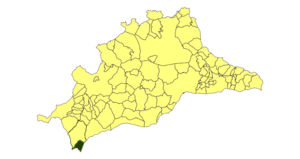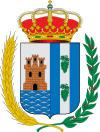Manilva facts for kids
Quick facts for kids
Manilva, Spain
|
|||
|---|---|---|---|

Duquesa Port, Manilva
|
|||
|
|||

Location of Manilva
|
|||
| Sovereign state | |||
| Autonomous community | |||
| Province | |||
| Area | |||
| • Total | 35 km2 (14 sq mi) | ||
| • Land | 35 km2 (14 sq mi) | ||
| • Water | 0.00 km2 (0 sq mi) | ||
| Population
(2023)
|
|||
| • Total | 17.774 | ||
| • Density | 0.508/km2 (1.315/sq mi) | ||
| Time zone | UTC+1 (CET) | ||
| • Summer (DST) | UTC+2 (CEST) | ||
| Website | http://www.manilva.es/ | ||
Manilva is a town located right on the coast in southern Spain. It's in the Province of Málaga, close to the border with the Province of Cádiz. Manilva is part of Andalusia, which is a large region in Spain. It's also part of an area called the Costa del Sol Occidental, famous for its sunny beaches.
Contents
History of Manilva
Early Settlements and Roman Times
Manilva's location near the entrance to the Mediterranean Sea has made it an important place for a very long time. People have lived here since the Stone Age! Recently, scientists found signs of these early people in caves in the Sierra Utrera mountains.
There's also an old Bronze Age hill fort in the area. Experts from all over Europe are currently studying it. This shows how important Manilva has been throughout history.
The area really became famous during the Roman period. The Romans had a busy fish processing industry here. They made a special paste called Garum, which was very popular in Rome. You can still see the remains of the Roman factory, a villa, and a bathhouse in Castillo de la Duquesa, a village near Manilva.
Founding and Growth of the Town
The town of Manilva itself was founded in the 16th century. It used to be part of a nearby town called Casares. But in 1795, Manilva became its own independent town.
For many years, the main jobs in Manilva were fishing, farming, and growing grapes. Manilva is especially known for its moscatel grapes. These grapes are used to make delicious raisins and fine wines.
Modern Manilva and Tourism
Since the 1970s, tourism has become a big part of Manilva's economy. A marina (a place for boats) and a golf course were built, attracting many visitors.
In recent years, Manilva has grown very quickly. It's one of the fastest-developing towns on the Costa del Sol. The number of people living here has almost tripled in the last 10 years!
The business world has also grown. There's now an industrial area near the A7 motorway. Many new shops and offices have also opened up.
Culture and Festivals
Annual Fairs and Celebrations
Like many towns in Andalusia, Manilva has an annual Feria (fair). Manilva's fair is usually held in the second week of August. This often lines up with Spain's public holiday on August 15th, which is Ascension Day.
Manilva has a very busy calendar of festivals and celebrations. Some are religious, some are traditional, and some are more modern.
Year-Round Festivities
- Three Kings Cavalcade (January 5): This fun parade celebrates the arrival of the Three Wise Men.
- Carnival (around Lent): Enjoy lively costumes, music, and dancing.
- Semana Santa (Easter): Solemn processions take place during Easter week.
- Manilva International Festival (late May): The town's international community shares its different cultures, foods, and traditions.
- Saint John's Eve (Summer Solstice): This ancient festival includes bonfires, fireworks, and parties that last until dawn.
- Virgen del Carmen (mid-July): Fishermen celebrate their patron saint, the Virgin del Carmen.
- Vendimia (first weekend of September): This festival celebrates Manilva's grape harvest. It's a big party for the town's famous grapes!
With many other Saints' days and pilgrimages, Manilva always has something to celebrate!
See also
 In Spanish: Manilva para niños
In Spanish: Manilva para niños



